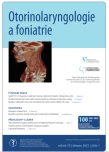Use of PET/ CT in diagnostics of distant metastasis and secondary malignancies in head and neck oncology
Authors:
Krátká Z. 1; Paska J. 1; Šíblová V. 1; Licková K. 2; Lohynská R. 3; Čoček A. 1
Authors‘ workplace:
ORL oddělení, Thomayerova nemocnice, Praha
1; Radioterapeutická a onkologická klinika 3. LF UK a FN Královské Vinohrady, Praha
2; Onkologická klinika 1. LF UK a Thomayerovy nemocnice, Praha
3
Published in:
Otorinolaryngol Foniatr, 70, 2021, No. 1, pp. 6-11.
Category:
Original Article
doi:
https://doi.org/10.48095/ccorl20216
Overview
Aim: Our goal was to assess our experience with accuracy of PET/ CT in the diagnostics of distant metastases and duplicity tumors in head and neck oncology. Methods: In total, 159 patients with a previously histologically verified malignant tumor of the head and neck underwent whole-body PET/ CT in our facility from 2016 to 2019. In 51 cases, we found out higher uptake of marked radiopharmaceutical (fluorodeoxyglucose) out of the head and neck region. In a retrospective study, we were evaluating the sensitivity and specificity of the method in the diagnostics of distant metastases and duplicities. Results: In our study, PET/ CT has sensitivity of 95.7% and specificity of 79.9% with positive and negative predictive values of 44.9% and 99.1% respectively. Conclusion: The method has a high sensitivity but lower specificity rate in the diagnostics of distant metastases (duplicity tumors) in head and neck oncology. Considering high radiation load and the price and availability of PET/ CT, it is necessary to consider the indication of this technique properly.
Keywords:
PET/ CT – head and neck cancer – staging – distant metastases
Sources
1. Dušek L, Mužík J, Kubásek M et al. Epidemiologie zhoubných nádorů v České republice [on-line]. Masarykova univerzita, [2005], [cit. 2020-2-08]. Verze 7.0 [2007]. [on-line]. Dostupné z URL: http:/ / www.svod.cz.
2. Stoyanov GS, Kitanova M, Dzhenkov DL et al. Demographics of Head and Neck Cancer Patients: A Single Institution Experience. Cureus 2017; 9(7): e1418. Doi: 10.7759/ cureus.1418.
3. Cadoni G, Giraldi L, Petrelli L et al. Prognostic factors in head and neck cancer: a 10-year retrospective analysis in a single-institution in Italy. Acta Otorhinolaryngol Ital 2017; 37(6): 458–466. Doi: 10.14639/ 0392-100X-1246.
4. de Bree R, Deurloo EE, Snow GB et al. Screening for distant metastases in patients with head and neck cancer. Laryngoscope 2000; 110(3 Pt 1): 397––401. Doi: 10.1097/ 00005537-200003000-00012.
5. Guizard AN, Dejardin OJ, Launay LC et al. Diagnosis and management of head and neck cancers in a high-incidence area in France: A population-based study. Medicine (Baltimore) 2017; 96(26): e7285. Doi: 10.1097/ MD.0000000000007285.
6. Agrawal A, Rangarajan V. Appropriateness criteria of FDG PET/ CT in oncology. Indian J Radiol Imaging 2015; 25(2): 88–101. Doi: 10.4103/ 0971-3026.155823.
7. Omami G, Tamimi D, Branstetter BF. Basic principles and applications of (18)F-FDG-PET/ CT in oral and maxillofacial imaging: A pictorial essay. Imaging Sci Dent 2014; 44(4): 325–332. Doi: 10.5624/ isd.2014.44.4.325.
8. Kaushik A, Jaimini A, Tripathi M et al. Estimation of radiation dose to patients from (18) FDG whole body PET/ CT investigations using dynamic PET scan protocol. Indian J Med Res 2015; 142(6): 721–731. Doi: 10.4103/ 0971-5916.174563.
9. Gourin CG, Watts T, Williams HT et al. Identification of distant metastases with PET-CT in patients with suspected recurrent head and neck cancer. Laryngoscope 2009; 119(4): 703–706. Doi: 10.1002/ lary.20118.
10. Goel R, Moore W, Sumer B et al. Clinical Practice in PET/ CT for the Management of Head and Neck Squamous Cell Cancer. AJR Am J Roentgenol 2017; 209(2): 289–303. Doi: 10.2214/ AJR.17.18301.
11. Glynn F, Brennan S, O‘Leary G. CT staging and surveillance of the thorax in patients with newly diagnosed and recurrent squamous cell carcinoma of the head and neck: is it necessary? Eur Arch Otorhinolaryngol 2006; 263(10): 943–945. Doi: 10.1007/ s00405-006-0094-y.
12. Gordin A, Golz A, Keidar Z et al. The role of FDG-PET/ CT imaging in head and neck malignant conditions: impact on diagnostic accuracy and patient care. Otolaryngol Head Neck Surg 2007; 137(1): 130–137. Doi: 10.1016/ j.otohns.2007.02.001.
13. Studer G, Lutolf UM, El-Bassiouni M et al. Volumetric staging (VS) is superior to TNM and AJCC staging in predicting outcome of head and neck cancer treated with IMRT. Acta Oncol 2007; 46(3): 386–394. Doi: 10.1080/ 02841860600815407.
14. Zanation AM, Sutton DK, Couch ME et al. Use, accuracy, and implications for patient management of [18F]-2-fluorodeoxyglucose-positron emission/ computerized tomography for head and neck tumors. Laryngoscope 2005; 115(7): 1186–1190. Doi: 10.1097/ 01.MLG.0000163763.89647.9F.
15. Kinahan PE, Fletcher JW. Positron emission tomography-computed tomography standardized uptake values in clinical practice and assessing response to therapy. Semin Ultrasound CT MR 2010; 31(6): 496–505. Doi: 10.1053/ j.sult.2010.10.001.
16. Cheung MK, Ong SY, Goyal U et al. False Positive Positron Emission Tomography / Computed Tomography Scans in Treated Head and Neck Cancers. Cureus 2017; 9(4): e1146. Doi: 10.7759/ cureus.1146.
17. Gregoire V, Lefebvre JL, Licitra L et al. Squamous cell carcinoma of the head and neck: EHNS-ESMO-ESTRO Clinical Practice Guidelines for diagnosis, treatment and follow-up. Ann Oncol 2010; 21 (Suppl 5): v184–186. Doi: 10.1093/ annonc/ mdq185.
Labels
Audiology Paediatric ENT ENT (Otorhinolaryngology)Article was published in
Otorhinolaryngology and Phoniatrics

2021 Issue 1
Most read in this issue
-
Stickler syndrome in the Czech Republic:
phenotypic variability and genetic heterogeneity -
Kikuchiho-Fujimotova choroba
(histiocytárna nekrotizujúca lymfadenitída) - Temporal bone meningioma
- The classification of tympanomastoid surgery for cholesteatoma by the new SAMEO-ATO system in clinical practice
